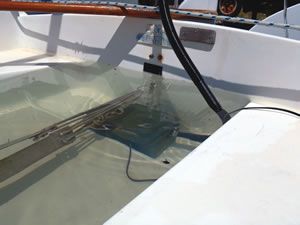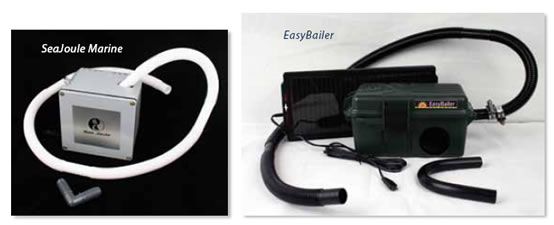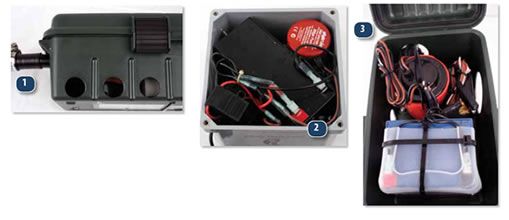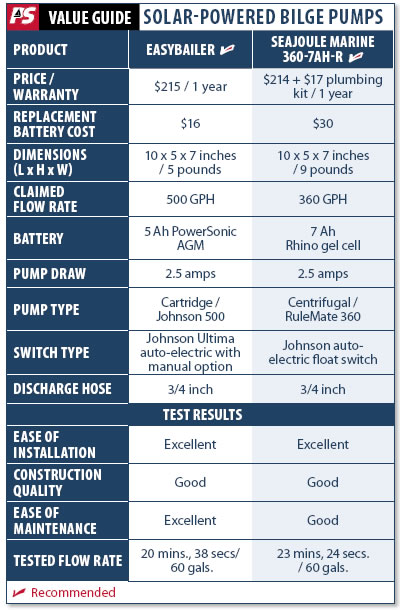
300
Although Practical Sailor’s home base is in the Sunshine State, the arrival of summer here is synonymous with daily rain showers. Typically, every afternoon in July and August will see some precipitation—either just enough rain to make the air steamy, or a full-force thunderstorm that leaves the air thick with electricity and the dinghy full of rainwater.
While we can’t stop the rain, we recently tested two devices that will at least stop the dinghy from floundering with all that rainwater. Designed for small boats, these petite pumps are solar-powered, self-contained systems that will cycle on automatically, easing the worry of leaving a boat unattended for extended periods and eliminating the need to hand bail when you return.
What We Tested
In the last year, Practical Sailor has tested a number of solutions for getting water out of a sailboat. We looked at low-capacity bilge pumps in the October 2010 issue, high-capacity pumps in September 2010, and Whale Pumps’ new Gulley IC smart shower pump in the April 2011 Chandlery.
For this report, testers checked out two solar-powered bilge pumps: the EasyBailer and the SeaJoule Solar Bilge Pump (model 360-7AH-R). Each self-contained system has a small re-chargeable battery; a fused, low-capacity electric pump; and a pump switch, all housed in a plastic box with a 3/4-inch discharge hose and a remote solar panel.
These kits are intended to be mounted at the low point of a dinghy’s or other small boat’s hull to discharge rainwater as it collects. They are not designed to serve as primary bilge pumps on sizable boats or to be used to pump dry a boat that’s already sinking.
A solar panel keeps the battery topped off, constantly re-charging it when the sun is shining so the pumps are ready when the rain is falling. Holes cut out of the side of the housing allows rising water to trigger the switch, and the pump cycles on once the water reaches certain depths. As the rain falls, the bailer pumps; once the water level decreases to a certain point, the pump stops.
Both the EasyBailer and the SeaJoule use remote Noco iMob solar panels (1.8 watt, 125 mA) to charge their 12-volt batteries. The portable panel comes with a 6-foot power cord and has mounting feet for fixed installations. Although the maker claims the Noco panel (model ISC125) works in all weather conditions and is waterproof, the EasyBailer manufacturer recommends never mounting it where it’s likely to be immersed. The panel, which has reverse charge and overcharge protection, is also touted as being shockproof; however, we recommend mounting it where it’s unlikely to be stepped on, sat on, or have gear piled atop it.
How We Tested
Testers evaluated each product’s components, quality of construction, features, how easily it could be maintained, and how well the electrical bits were wired and protected. To gauge performance, testers simulated an “extreme” rainstorm. The test platform was an O’Day Javelin daysailor named Misty. At 14-feet, Misty’s the smallest boat in the PS fleet, and perfectly sized for testing these petite bilge pump systems.
Testers set the products out in the Florida sun until the batteries reached their maximum charge; this didn’t take long as both the SeaJoule and EasyBailer were shipped to us with nearly full charges. The products were then each mounted at the lowest point of the Javelin’s cockpit, a small V-section located under the tiller. We installed each one per makers’ directions and rated them on instruction quality and ease of installation. Both kits were sent to PS with everything needed for installation and easy-to-follow instructions, so it was basically plug and play: Plug the panel into the unit’s power connection, set the panel in direct sunlight, set the bailer box in the bottom of the boat, attach the drain hose with a hose clamp, and secure the hose discharge so that it’s bailing water out of the boat and into the drink. (Users will need screwdrivers and a drill for a permanent installation.)
Head pressure is the resistance that a pump has to overcome when pumping water up and out of the boat. It includes the resistance generated by the vertical distance the pump has to move the water up. Our test runs included 4 feet of head, the maximum possible given the supplied hose lengths.

To really challenge the pumps, we filled the 8.5-foot-by 2.25-foot cockpit with 60 gallons of fresh water—to the top of the seats—and let each product have a go at emptying the water out. Testers timed how long it took each pump to empty the known volume, and then used this to get an idea of its real-world flow rate.
Both pumps turn on automatically when the water level reaches 2 inches and turn off when the water recedes to three-quarters of an inch; both also can be manually switched on. Neither product had any problem handling the 60-gallon deluge, and both pumps left only about 5 cups of water in the cockpit’s V-section.
Note that the makers caution against submerging these pumps, but the test pumps seemed to suffer no ill effects from our submerging them. However, what we did would void the SeaJoule’s one-year warranty.
With most solar-powered gear, we like to test the battery’s run time on a single full charge. However, that wouldn’t be a realistic rating criteria for these products since it’s unlikely that there ever would be a real-world circumstance where the sun doesn’t shine long enough to re-charge the battery at least partially after use (unless you live somewhere with really crummy weather).
EasyBailer
The EasyBailer is the creation of John Bianchi, a small-boater homeported in Maine, where the products are manufactured. Bianchi sought a convenient, reliable, self-contained bilge pump setup for his small boats and dinghies that would automatically clear out rainwater, and what he came up with was the EasyBailer.
The EasyBailer is housed in a tackle-box-style drybox (made by MTM) with plastic flip-up latches and plastic hinges. It comprises a Johnson Pump 500 cartridge-style bilge pump, a 5-amp-hour re-chargeable AGM battery, a Johnson Ultima electronic water-level switch, the Noco solar panel with cord, two stainless hose clamps, 4 feet of hose, and a U-shaped loop (to run the hose over the boat’s rail).
The plastic box offers great access to the pump and other parts for maintenance, but testers question the long-term durability of its three plastic hinges. We’d expect them to eventually break if left to endure constant UV exposure for the longhaul. However, Bianchi said that he has never had any reports of hinge failures in the three years he’s been selling EasyBailers.
All of the electrical connections were well made and heat-shrink wrapped for protection. They also come pre-coated with dielectric grease to prevent corrosion. The pump’s 5-amp fuse is wrapped and coated, but it isn’t watertight.
To direct the EasyBailer’s discharge hose over the boat’s side, the maker supplies a wide U-shaped hose connector. We preferred it over the SeaJoule’s 90-degree elbow connector because the U shape was a better fit over the dinghy rail, and its shape is also easier on the pump than having to move water through a sharp bend.
In our downpour simulation, the EasyBailer cleared out the 60 gallons of water a few minutes faster than the SeaJoule bailed the same volume. (See Value Guide.) Testers attributed this to the fact that its pump has a 500-GPH capacity verses the SeaJoule’s 360-GPH capacity.
The EasyBailer runs on a 5-amp-hour Power Sonic (PS 1250) AGM battery, which has a life expectancy of about three to five years. Bianchi said he’s never had to replace an over-the-hill one, but you can buy battery replacements from Bianchi for $16 (plus shipping) or find them online for $10-$15.

SeaJoule
Based in New York, SeaJoule Marine Inc. manufactures two solar bilge pumps, one with a fixed solar panel and one with a remote panel; we tested the remote option.
The SeaJoule we tested is housed in a heavy-duty PVC-plastic box that resembles an outdoor electrical box. The square housing has a gasketed lid secured with four slotted screws. The SeaJoule kit comprises a Rule Mate 500 centrifugal pump, the Noco solar panel, a Johnson electronic float switch, a 7-amp-hour Rhino gel-cell battery, an assortment of mounting hardware, and a heavy-duty locking point for securing the unit to the boat. The plumbing kit— 4 feet of discharge hose, a plastic elbow hose connector, and hardware—is sold separately for $17. All of its wire connections and fuse are watertight.
The biggest design gripe testers had about the SeaJoule was its limited access for servicing the pump, battery, and switch. Even with the box’s lid removed, the parts are squeezed in so tightly that a user would have to remove the battery to get the pump out for cleaning.
Unlike electronic switches, float switches have moving parts that can become fouled. The SeaJoule switch, however, is enclosed, making it less likely to clog, and a plastic screen in the hole by the float switch further prevents fouling. The screen on our test unit never popped in well though, and it had a tendency to fall out during use. According to SeaJoule, the maker opted for a float switch to avoid the very slight but constant power draw inherent with using an electronic switch.
In under 24 minutes, the 360-GPH SeaJoule cleaned up all but 5 cups of the 60 gallons in our simulated downpour. Its lower capacity put it a little behind the EasyBailer in speed, but not by much.
The SeaJoule’s 7-amp-hour gel-cell battery has 30-percent more capacity than the EasyBailer battery, a small bonus. The maker sells replacement batteries for $30, and we also found them online for $13-$16.
Bottom Line
If you’re like us, the first thing you thought when you saw these pumps was: “That’s a great idea!,” and the second was “I bet I can make one for less money!”
We priced out the DIY project and concluded that we could indeed build a custom solar-powered dinghy bailer for less money. Including all the components—the housing, pump, switch, electrical connections, etc.—our estimate came to about $120-$150. That savings may be more than enough motivation for the DIYer who has the tools and know-how to turn a dry box into a pump housing and carefully make all the electrical connections.
But if dinghy-bailer building isn’t your forte, we recommend the EasyBailer or the SeaJoule. Both are well made, and more importantly, they are already made. They are very close in performance and price, so the decision comes down to features, reliability, and which one will last the longest.
The SeaJoule’s housing is definitely more robust and durable than that of the EasyBailer, but it uses the less-desirable float switch and the required plumbing parts cost extra. Its bulletproof casing, which will definitely outlast its innards, also makes it more work to service the components. While testers liked the EasyBailer’s easy-to-clean cartridge pump and non-clogging switch, we would like to see a more beefy housing.
Whether you build your own dinghy bailer or buy a pre-fab one, remember to keep the space being pumped out clean. Debris can clog the pumps, but more importantly, these automatic bailers will automatically suck up any liquid pooling in the boat and spit it into the waterway, including spilled fuel and oil.






































